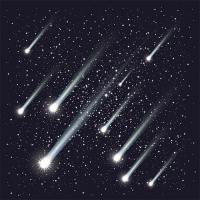Meteor Shower Schedule 2017
017 Meteor Shower Guide shows peak dates for 2017 meteor showers:
Jan. 3-4, Quadrantids meteor shower: This better-than-average meteor shower will usher in the new year, producing 40 shooting stars an hour at its peak. The shower, believed to be produced by dust grains left behind by an extinct comet known as 2003 EH1, runs annually from Jan. 1-5. Best viewing times are shortly after midnight. Meteors radiate from the constellation Bootes, but you can see them from anywhere in the sky.
April 22-23, Lyrids meteor shower: Produced by dust particles left behind by comet C/1861 G1 Thrasher, discovered in 1861, the Lyrids is an only an average meteor shower producing about 20 meteors an hour. It originates from the constellation Lyra, but you’ll be able to see them from anywhere in the sky. The crescent moon shouldn’t cause too much of a problem during the shower’s peak. The best viewing times for this shower are after midnight.
May 6-7, Eta Aquarids meteor shower: This shower favors the Southern Hemisphere — about 60 shooting stars an hour will be visible there — but the Northern Hemisphere won’t be entirely left out of action, and the rate could approach 30 an hour. The shower runs annually from April 19-May 28, but peaks on the night of May 6 and morning of May 7. A waxing gibbous moon — that is, a moon that appears high in the east at sunset, and is more than half-lighted, but less than full — could block out the most distant meteors, but patience pays off here. If you wait long enough, you should be able to see the brighter ones. Meteors in this shower radiate from the constellation Aquarius, but you should be able to see them anywhere in the sky.
July 28-29, Delta Aquarids meteor shower: Radiating from the constellation Aquarius but visible anywhere from the sky, this meteor shower produces about 20 meteors an hour at its peak. It runs from July 12-Aug. 13. A crescent moon will have set by midnight, leaving dark skies for the early morning show.
Aug. 12-13, Perseids meteor shower: This is the one you’ve waited for all year. Produced by the comet Swift-Tuttle, It usually produces about 60 meteors per hour. They’re not just any shooting stars, either — the Perseids are known for producing a large number of blazing bright meteors. The shower runs from July 17-Aug. 24, overlapping some with the Delta Aquarids, and is best seen late at night or in the early morning of the peak dates of Aug. 12-13. There’s a waning gibbous moon — it appears less than half full, but more than half lights — and that could block out the fainter meteors, but the Perseids are so bright that you should still plan on catching the show. The meteors radiate from the constellation Perseus, but you’ll be able to see them no matter where you’re looking in the sky.
Oct. 7, Draconids meteor shower: Produced by the dust grains left behind by comet 21P Giacobini-Zinner and, discovered in 1900, the Draconids radiate from the constellation Draco, but are visible anywhere in the sky. This is typically a sleepy show, producing only about 10 meteors an hour — unless Draco the Dragon breathes fire, and then settle in for an amazing show. In rare instances, Draco can fire off hundreds of meteors in a single hour, and you should hope for that, because a nearly full moon will block all but the brightest. Unlike other meteor showers, the best viewing time is in the early evening. The shower runs from Oct. 6-10, but peaks Oct. 7.
Oct. 21-22, Orionids meteor shower: This shower, which runs annually from Oct. 2-Nov. 7 and peaks the night of Oct. 21 and morning of Oct. 22, produces about 20 meteors per hour at its peak. It is produced by dust grains left behind the ancient comet Halley and originates from the constellation Orion, but you’ll be able to see it from anywhere in the sky. A crescent moon will set early in the evening, leaving the dark skies that are ideal for viewing. The best viewing time is after midnight.
Nov. 4-5 Taurids meteor shower: This long-running shooting star show from Sept. 7-Dec. 10, is actually a two-fer — the South Taurids, which peak Nov. 4-5, and the North Taurids, which peak Nov. 11-12. The North Taurids originate from dust grains left behind by the Asteroid 2004 TG10, while the second is the result of debris left behind by behind by Comet EP Encke. A full moon on Nov. 4 will steal the show, but if you’re patient you may be able to see some, but gy Nov. 11-12, viewing conditions will improve. These typically slow-moving meteors radiate from the constellation Taurus, but you’ll be able to see them anywhere in the sky.
Nov. 17-18, Leonids meteor shower: This shower, which runs annually from Nov. 6-30, is both average and unique. It’s average in that it will only produces about 15 meteors an hour at its peak on the night of Nov. 17 and morning of Nov. 18, but every 33 years, it has a cyclonic peak that results in hundreds of meteors an hour. The last time this happened was in 2001, so it will be 2034 before that happens again. Produced by dust grains left behind by comet Tempel-Tuttle, discovered in 1865, the meteors radiate from the constellation Leo, but just look up and you should see some. With a new moon, skies should be dark enough for a good show. The best viewing time is after midnight.
Dec. 13-14, Geminids meteor shower: You’ve been waiting for this one, too, and it will outshine the Perseids. Running annually from Dec. 7-17, it peaks the night of Dec. 13 and morning of Dec. 14, when it could produce up to 120 multicolored meteors per hour. It’s left behind by debris dust from an the 3200 Phaethon asteroid, discovered in 1982. A waning crescent moon won’t give much competition, and you should be in for an excellent show. The best viewing time is after midnight. The shooting stars radiate from the constellation Gemini, but can appear anywhere in the sky.
Dec. 21-22, Ursids meteor shower: Produced by dust grains left behind by the comet Tuttle, first discovered in 1790, this shower runs annually from Dec. 17-25 and will peak in 2017 on the night of Dec. 21 and morning of Dec. 10. It’s a minor shower, producing only about 5-10 shooting stars an hour. The crescent moon will set early in the evening, leaving dark skies. The best viewing time is just after midnight. Meteors radiating from the constellation Ursa Minor are visible anywhere in the sky.
- ·
- December 19, 2016 2:34 am

To Achieve The American Dream Remember Your ABCs Acrylic Wall Art by Wanda_Hope_Carter
View more American Acrylic Wall Arts at zazzle.com








